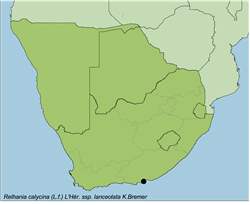Names and synonyms
Relhania calycina (L.f.) L'Herit. ssp. lanceolata Bremer=Relhania calycina (L.f.) L'H�r. p.p.
Type
Paterson 312, Port Elizabeth, Redhouse, 1914 (BOL).
Derivation of names
Relhania = after Irish-born Richard Relhan (1754-1823), botanist, plant collector, bryologist, lichenologist, one of the founders of the Linnean Society, rector in Lincolnshire and author of Flora Cantabile.calycinus: kalux = case of bud, husk, calyx-likelanceolata = shaped like a small lance
Diagnostic characters
Leaves pilose, lanceolate and slightly curved backwards.
Description
Plant sparsely branched, usually long and slender, often 0.4- 1 m tall. Stems tomentose, leafy, becoming glabrous and nude and marked with leaf-scars. Leaves � straight or slightly curved backwards, lanceolate, 8-22 x 1-6 mm, quite distinctly 3-5-nerved, pilose, acute, sometimes pungent. Capitula solitary, sessile, terminal. Involucre widely bell-shaped, 8-20 mm wide. Involucral bracts 30-75, outer ovate, inner gradually longer with a spreading, brownish apical limb. Receptacle flat-convex, paleate. Paleae canaliculate and often winged, 7-11.5 x 0.3-0.8 mm, acute-acuminate, persistent. Ray florets 15-40. tube somewhat triquetrous, 3-5 mm long, with subulate-triangular hairs, lamina narrowly elliptic, 8.5-14 x 1.6-2.9 mm, 4- or occasionally 5-6-veined. Disc florets 50-250, perfect. Pappus crownlike, of � connate scales, up to 2 mm long. Cypselas flat with inner edge often winged, elliptic-oblong, 2.2-3.5 x 0.6-1.3 mm wide, glabrous or pilose mainly on inner edge and with occasional scattered hairs.
Flowering time
Mainly from October to January.
Distribution
Ssp. lanceolata, occurs from Humansdorp to Albany.Known from only a few specimens.
Habitat
Ssp. lanceolata occurs on stony or clayey, sometimes calcareous soil on flats and lower hills.
Notes
Ssp. lanceolata consists of small shrubs with smaller, lanceolate leaves, which are often slightly curved backwards and pungent. The indumentum is variable, but similar to that of ssp. calycina. The capitula also seem to be smaller with fewer florets than in the other subspecies.
Key to the subspecies 1a. Leaves dorsally and marginally pilose-tomentose with persistent hairs ............................... 21b. Leaves quite glabrous (occasionally very laxly pilose with deciduous hairs) ...... ssp. apiculata 2a. Leaves � straight, narrowly elliptic-oblong-elliptic-obovate................................ ssp. calycina 2b. Leaves slightly curved backwards, lanceolate ................................................... ssp. lanceolata
References
BREMER, K. 1976. The genus Relhania (Compositae). Opera Botanica 40. GLEN, H.F. 2004. SAPPI, What's in a Name? The Meanings of the Botanical Names of Trees. Jacana.KESTING, D. & CLARKE, H. 2008. Botanical names, what they mean. Wild Flowers of the Cape Peninsula, 3rd revised edition. Friends of Silvermine.
